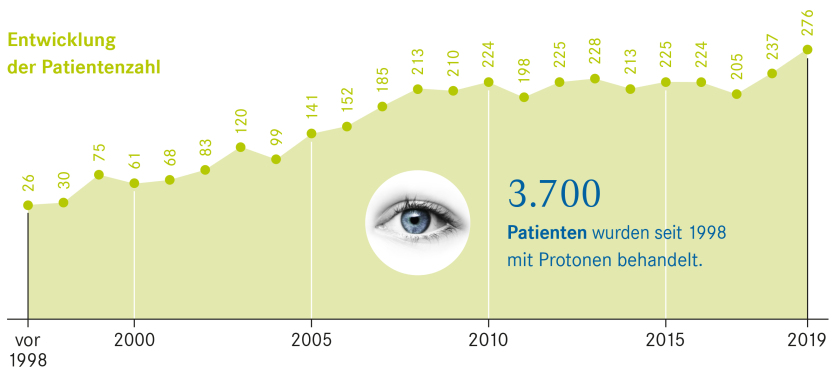20 percent more patients were treated with proton therapy in 2019

An individual eye shield is made for each patient to protect the surrounding tissue from the proton beam. © HZB

Number of patients who received the proton therapy offered jointly by Charité and HZB. © HZB/J. Politt
For more than 20 years, Charité - Universitätsmedizin Berlin and the Helmholtz-Zentrum Berlin (HZB) have jointly offered the irradiation of eye tumors with protons. In 2019, more patients were treated in Berlin-Wannsee than ever before. 276 patients - 20 percent more than in the previous year - underwent proton therapy. The treatment is specialized in choroidal melanomas of the eye. The proton accelerator at HZB is the only treatment facility for this disease in Germany.
500 to 600 people in Germany are affected by a malignant choroidal melanoma every year. In 97 percent of cases, the tumour can be completely destroyed by irradiation with protons. In most cases, not only the eye but also the vision can be maintained to a satisfactory degree. "The energy of the proton beam can be adjusted in such a way that practically only the tumor receives the radiation. Since the protons have a straight trajectory, the lateral scattering is much less than with X-rays," explains Dr. Jens Heufelder, the senior medical physicist at Charité - Universitätsmedizin Berlin. The protons effectively destroy the tumor, while the surrounding healthy tissue is largely spared.
To cope with the increase in patients in 2019, treatment operations at the proton accelerator have been extended to 12 hours. Approximately 45 percent of the patients came from the Berlin-Brandenburg region, the other patients came from other German states and other European countries (approximately 8 percent). The youngest patient who received proton therapy at HZB in 2019 was 8 years old, the oldest patient 96 years old. The average age was 61 years.
Since 1998, more than 3,700 patients have been treated with protons from the HZB accelerator. "The success of proton therapy is based on the collaboration between ophthalmologists, medical physicists and accelerator experts. As a result, the therapy has been continuously improved for the benefit of patients over the past few years", explains Prof. Dr. Andrea Denker, head of proton therapy at HZB.
(sz)
https://www.helmholtz-berlin.de/pubbin/news_seite?nid=21122;sprache=en
- Copy link
-
Long-term stability for perovskite solar cells: a big step forward
Perovskite solar cells are inexpensive to produce and generate a high amount of electric power per surface area. However, they are not yet stable enough, losing efficiency more rapidly than the silicon market standard. Now, an international team led by Prof. Dr. Antonio Abate has dramatically increased their stability by applying a novel coating to the interface between the surface of the perovskite and the top contact layer. This has even boosted efficiency to almost 27%, which represents the state-of-the-art. After 1,200 hours of continuous operation under standard illumination, no decrease in efficiency was observed. The study involved research teams from China, Italy, Switzerland and Germany and has been published in Nature Photonics.
-
Electrocatalysis with dual functionality – an overview
Hybrid electrocatalysts can produce green hydrogen, for example, and valuable organic compounds simultaneously. This promises economically viable applications. However, the complex catalytic reactions involved in producing organic compounds are not yet fully understood. Modern X-ray methods at synchrotron sources such as BESSY II, enable catalyst materials and the reactions occurring on their surfaces to be analysed in real time, in situ and under real operating conditions. This provides insights that can be used for targeted optimisation. A team has now published an overview of the current state of knowledge in Nature Reviews Chemistry.
-
BESSY II: Phosphorus chains – a 1D material with 1D electronic properties
For the first time, a team at BESSY II has succeeded in demonstrating the one-dimensional electronic properties in phosphorus. The samples consisted of short chains of phosphorus atoms that self-organise at specific angles on a silver substrate. Through sophisticated analysis, the team was able to disentangle the contributions of these differently aligned chains. This revealed that the electronic properties of each chain are indeed one-dimensional. Calculations predict an exciting phase transition to be expected as soon as these chains are more closely packed. While material consisting of individual chains with longer distances is semiconducting, a very dense chain structure would be metallic.
